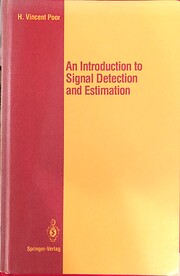

Klik op een omslag om naar Google Boeken te gaan.
|
Bezig met laden... Introduction to Signal Detection and Estimation (Springer Texts in Electrical Engineering) (editie 1988)door H. Vincent Poor (Auteur)
Informatie over het werkAn introduction to signal detection and estimation door H. Vincent Poor
 Geen Bezig met laden...
Meld je aan bij LibraryThing om erachter te komen of je dit boek goed zult vinden. Op dit moment geen Discussie gesprekken over dit boek. Geen besprekingen geen besprekingen | voeg een bespreking toe
The purpose of this book is to introduce the reader to the basic theory of signal detection and estimation. It is assumed that the reader has a working knowledge of applied probability and random processes such as that taught in a typical first-semester graduate engineering course on these subjects. This material is covered, for example, in the book by Wong (1983) in this series. More advanced concepts in these areas are introduced where needed, primarily in Chapters VI and VII, where continuous-time problems are treated. This book is adapted from a one-semester, second-tier graduate course taught at the University of Illinois and at Princeton University. However, this material can also be used for a shorter or first-tier course by restricting coverage to Chapters I through V, which for the most part can be read with a background of only the basics of applied probability, including random vectors and conditional expectations. Sufficient background for the latter option is given for example in the book by Thomas (1986), also in this series. This treatment is also suitable for use as a text in other modes. For example, two smaller courses, one in signal detection (Chapters II, III, and VI) and one in estimation (Chapters IV, V, and VII), can be taught from the materials as organized here. Similarly, an introductory-level course (Chapters I through IV) followed by a more advanced course (Chapters V through VII) is another possibility. Geen bibliotheekbeschrijvingen gevonden. |
Actuele discussiesGeenPopulaire omslagen
 Google Books — Bezig met laden... Google Books — Bezig met laden...GenresDewey Decimale Classificatie (DDC)621.382Technology Engineering and allied operations Applied physics Electrical, magnetic, optical, communications, computer engineering; electronics, lighting Electronics, communications engineering CommunicationsLC-classificatieWaarderingGemiddelde: (3.5) (3.5)
Ben jij dit?Word een LibraryThing Auteur. |
||||||||||||||||||||||||||||||||||||||||||||||||||||||||||||||||||||||||||||||||||||||||||||||||||||||||||||||||||||||||||||||||||||||